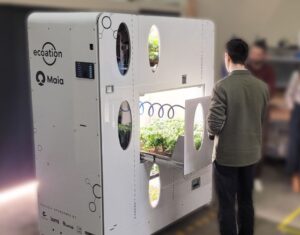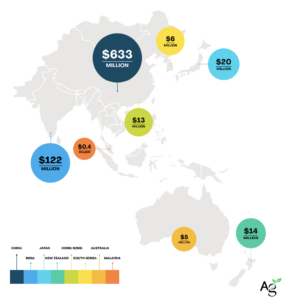Access to vertical farming technologies is deepening and widening across the world, bringing down the costs and hassle of locally producing anything from Singaporean strawberries to Arctic tomatoes.
In Latin America, however, indoor vertical farms are still largely written off on a continent thought of in terms of its abundant fertile soil and plentiful sunlight. Why pay for artificial light or indoor automation when the sun is free, and labor and land are cheap?
That said, there are early signs of a Latin American vertical farming awakening in Chile, where AgroUrbana has just closed a $1 million seed round, bringing its total capital raised to $1.5 million. The startup has created South America’s first vertical farm, according to the Association for Vertical Farming.
Leading the round by contributing 33% of the cash was the CLIN Private Investment Fund administered by Chile Global Ventures, the VC arm of Fundación Chile, a public-private initiative for innovation and sustainability in the country. Support financing also came from CORFO, Chile’s economic development agency, and private investors like company builder and VC Engie Factory, the country’s largest telecommunications company Entel, and sustainability investor Zoma Capital.
In an interview with AFN, AgroUrbana founders Cristián Sjögren and Pablo Bunster described how the funds would be put to work at their 3,000 square feet pilot facility in the suburbs of Santiago, where testing is ongoing on layered, renewable energy-powered stacks of hydroponically grown, LED-lit leafy greens and fruits. AgroUrbana’s first big offtake deal has just been inked with a major Chilean grocery retailer, they said.
A pre-planned switch from restaurant to retail
“It’s been run, run, run,” Bunster recalls, describing the political turmoil in Chile that brought curfews and shuttered restaurants months before Covid-19 locked down the country. That earlier disruption, he adds, actually had its upsides, as it got them thinking more about e-commerce and direct-to-consumer sales — so when the team’s restaurant deals dried up during the Covid-19 pandemic, the switch to retail was already scoped out.
As to scaling up further, Sjögren envisions an eventual 30,000 square foot facility to be bankrolled by Series A funding they plan to work towards later this year. The design and output would depend on the results of their pilot trials.
This size of farm sets the team somewhere in the middle of the two dominant visions of vertical farming: centralized versus distributed. Proponents of centralized systems argue that large-scale production — and financial viability — depend on ever-bigger and higher farms. These farms — or plant factories as they are sometimes called — are proliferating, aided by huge sums of capital. Plenty scooped up a whopping $200 million in Series B funding back in 2017. AeroFarms raised $100 million in late-stage funding in 2019 while Fifth Season secured $50 million last year.
Although centralized facilities have generally dominated in terms of raising capital, distributed and decentralized business models are gaining pace according to AgFunder’s 2019 industry report. One in particular, Germany’s Infarm, nabbed $100 million last year to deploy its connected growing cabinets in supermarkets.
The theatricality of these cabinets harmoniously glowing in office buildings or hospitals in a post-coronavirus world also holds sway in the popular and corporate imagination of 2020. Companies like Square Mile Farms recently crowdfunding over $300,000 on the promise of re-kitting office spaces like Microsoft’s London premises with fresh produce. In New York, Farmshelf has its own grow cabinets deployed in WeWork FoodLabs.
Learning from cash-heavy first movers
Mention of relative giants like Plenty or InFarm could be daunting for newer entrants such as Square Mile Farms or AgroUrbana and their hitherto modest sums raised. But there is perhaps an advantage in starting late, so long as the team learns from the costly mistakes and hubris of earlier endeavours. Here, both Bunster and Sjögren see parallels with the renewable energy industry — where they worked previously — and see the arrival of cheaper, more sustainable energy and capital in Chile as crucial to making vertical farming competitive.
AgroUrbana is exploring three options for solar going forward: either establish a power purchase agreement, in which they buy renewable energy from an existing plant; finance a power plant which will sell energy to them later; or build their own solar farm. But they acknowledge that the larger the facility, the less feasible it is to have solar on-site.
The pair describe how some Chilean outdoor farming is already lean and competitive, yet much of it has been geared towards high-value crops like avocados – and that stuff is primed for export. For the urbanizing local market, they see gaps for hyper-local fresh produce, where the competition would actually be with low-tech smallholder farmers with less traceable supply chains. In the context of Covid-19 and an ensuing consumer embrace of e-commerce options, better nutrition, less water use, and fewer pesticides, the pair reckon there is much to gain from providing produce that is consistently fresh, 365 days a year.
Any chance of the world’s first vertically-farmed avocados any time soon? Unlikely, replies Bunster. As for gene editing, where South American jurisdictions are known to have more lax regulations than their North American counterparts, Bunster says the plan was to work with what nature already provides, while giving “the conditions of spring every day of the year.”

















Sponsored
International Fresh Produce Association launches year 3 of its produce accelerator